�
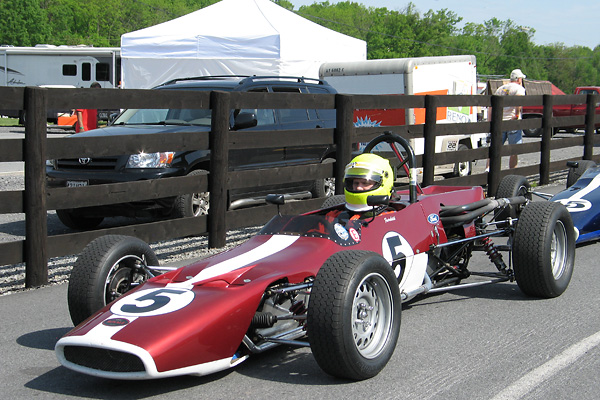
�
Scott Fairchild's 1972 Royale RP3-A Formula Ford Racecar
� � Owner: Scott Fairchild� City: Powhatan Virginia
� Model: 1972 Royale RP3-A
� Engine: 1.6L Ford four-cylinder
� Race prepared by: owner�
�
The Early History of Royale Racing Cars
��
The Royale story starts with an enthusiastic amateur racer named Bob King, who built a �
small performance shop behind his home. When business warranted, King moved his shop to a �
rental unit under the railway viaduct arches at Wembley and renamed his business "Racing �
Preparations Ltd.". Racing Preparations quickly developed a sterling reputation for �
excellence in tuning Coventry Climax engines. �
�
In 1964, to increase production capacity so they could meet demand for their new V12 �
engine, Jaguar bought the Coventry Climax engine company. Jaguar then decided to liquidate �
Climax's non-production assets. Bob King found himself in the right place at the right time, and �
bought out the whole inventory of Climax engines and parts and also rights to the firm's designs �
(not including the V8). Selling Climax engines and spares made a nice side business for his �
young company, but King also continued providing all sorts of tuning and modification services�
for local racers.�
�
In early 1968, an Alexis Formula Ford arrived at the Racing Preparations shop for service. �
This particular Alexis was one of the early 1500cc cars (from 1967), and it belonged to a �
man named Bill Tooth, who coincidentally had a young driver named James Hunt driving for him. �
Tooth had brought his Alexis to Racing Preparations to have the engine dry-sumped. Ever on �
the lookout for new business opportunities, King observed that although Alexis seemed to be �
selling a lot of Formula Fords, their chassis had obvious shortcomings. He was particularly �
critical of its apparent lack of rigidity and he felt that he could probably develop and �
market a better car. He further reasoned that he already had business relationships with all �
the appropriate suppliers, including Arch Motors for frames (which Royale would use for many �
years, on all but their first few cars) and Specialised Mouldings for fiberglass bodywork.�
�
Please support the sponsoring companies who make www.BritishRaceCar.com possible, including:
� �
 �
�
�
�
�
Bob King hired Bob Marston on a freelance basis to design the new Formula Ford and then the �
sports racer that followed it. (The sports racer was for a short-lived racing series called �
"F100" which was sponsored by the Firestone tire company. Royale cars dominated the series through �
its two year existance.) At the beginning of this period, Bob Marston was working for the �
Cooper race team but he was willing to work on other design projects in his spare time. �
Cooper was focused on Formula One, Two and Three - so there was no conflict of interest. �
As Bob recalls: "Later in 1968 I joined John Surtees from Coopers but when he moved his factory �
to Edenbridge in Kent at the back end of that year I resigned and joined Lola where I stayed �
for the next 13 or so years. To be honest, I seem to have been credited with much more Royale �
design work than I actually did! I think what actually happened was that any basic design that �
I did which was subsequently updated (to become next year's model), retained me as the named �
designer even though the updates were initiated and carried out by Bob King / Alan Cornock �
with maybe a verbal input from me."¹�
�
�
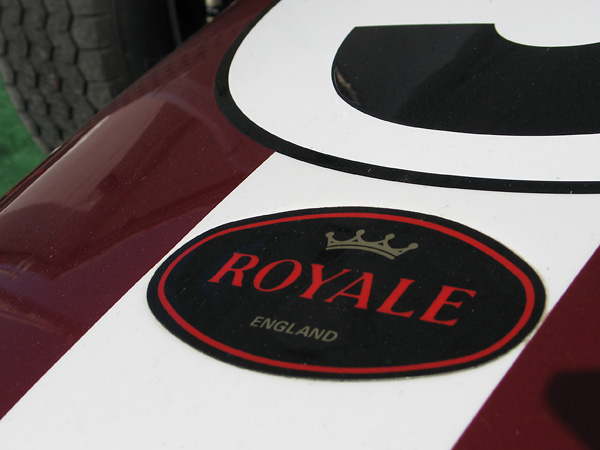
�
Bob King chose to be "Royale" the tradename for racecars produced by his company, Racing
�
Preparations Ltd. He chose the name based on his own surname. Soon after starting Formula Ford
�
production King decided to relocate his company to the Park Royal neighborhood of London, and that
�
reinforced customer association with the name. The original company name was soon dropped in favor
�
of the more memorable brand name.
�
�
Bob Marston continued: "I seem to remember that even in those early days I identified chassis �
stiffness as possibly the most fundamentally important reqirement for any design and hence the �
emphasis was put on that. So far as suspension geometry, weight distribution, etc., and all �
the other myriad of details that go into a design, I don't recollect any details whatsoever �
although come to think of it I do seem to remember Bob King having a stipulation for driver �
comfort." �
�
There are many aspects of the Royale design that differ dramatically from contemporaries.�
The spaceframe is more elaborate, with tubes of various diameters and particularly more �
small diameter tubing. Royale never embraced the briefly fashionable idea of circulating�
engine coolant through frame tubes. Recognizing that the cockpit opening is inevitably the�
weakest part of any open car, they minimized its size rather more than most. The top of�
the engine bay is similarly challenging; like contemporaries Royale provided a bolt-in �
brace, but their's connects all four corners of the bay and is symmetrical. In terms of �
specification, the early Royale's were rather deluxe. For example, use of adjustable Heim�
joints at suspension joints where others used simple bushings drove up build cost, but �
made Royale suspensions both easier to adjust and also more precise. The result of these �
design decisions is that early Royale Formula Ford racecars sold at a premium price and �
were rarely deeply discounted.�
�
To potential customers, design features are one thing and race victories are another.�
The marque that wins on Sunday, sells on Monday. Royale was successful, but frankly home�
market sales were less impressive than export sales. Royales sold strongly in North America�
where race wins reinforced their reputation for quality. In 1969, Bill Scott won the �
"World Championship of Formula Ford" in Sebring Florida with his RP2, and finished �
second place in that year's SCCA runoffs to Skip Barber. (Scott later won several �
Super Vee championships in Royales.) In 1970, driving the new RP3 model, Dick Allen �
won the SCCA's NE Division Formula Ford championship and Jim Aronson won the SE Division �
championship. In that same year, SCCA records show that Royale Formula Fords scored �
37 wins, 16 second places, 11 third places, and set 10 new track records. �
Royale's Early Formula Ford Production by Model
�| Model | Years | # Built | Notes |
| RP1 | 1968 | 1 | The original prototype. Later sold, raced, and eventually destroyed. First track test: August 7, 1968. First race: January 19, 1969. |
| RP2 | 1969 | 30 | 19 of the 30 were built for U.S. customers. (18 of the 19 were sold by Bill Custer of Illinois.) U.K. price was £1050, less engine. |
| RP3 | 1970 | 12 | 8 of the 12 were built for U.S. customers. (All eight of these were sold by Bill Scott). 2 for Canadian customers. |
| RP3A | 1971/72 | 20 | 9 of the 20 were built for U.S. customers. (8 of the 9 were sold by Bill Scott.) 2 for Canadian customers, including the car shown here. 1971 U.K. price was £1175, less engine. |
�
Great results in the home market would follow in time - earned by racing victories and by successive�
car designs. �
�
This is the wrong place to tell the rest of Royale's history. Although Royale cars competed �
in many racing classes, their reputation was earned in Formula Ford and that's where they �
found their greatest and most enduring success. Between 1968 and 1987, Royale produced �
735 racecars, 502 of which were 1600cc Formula Fords. �
�
�
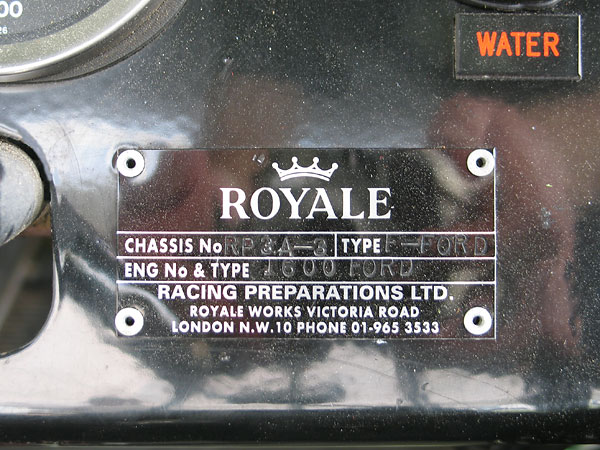
�
Royale
�
Chassis No.: RP3A-3, Type: F-Ford
�
Eng No. & Type: 1600 Ford
�
Racing Preparations Ltd.
�
Royale Works, Victoria Road
�
London N.W.10, Phone 01-965 3533
�
Scott Fairchild's Royale RP3-A
��
Royale company records indicate that chassis RP3A number 3 was originally purchased by �
Bryan Evans of Canada. Little is known about the early history of this car, except that �
in 1974 Bryan Evans used it to handily win the 17th running of the famous Knox Mountain �
Hillclimb in Kelowna, British Columbia. �
�
Scott Fairchild bought Royale RP3-A serial number 3 in December 2005. The Royale was �
already restored to excellent condition and it was exceptionally clean. The previous �
owner had just treated the car to a new basecoat/clearcoat paintjob, and the car �
largely retains the appearance of when it was purchased. However, Scott enjoys race �
car preparation and has made many subtle improvements to the Royale set-up while �
maintaining a very active racing schedule over the following years. Scott primarily �
races with the Sportscar Vintage Racing Association (SVRA) and with the Vintage Racer �
Group (VRG).�
�
Enjoying this article? www.BritishRaceCar.com is partially funded through generous support from readers like you!
�
To contribute to our operating budget, please click here and follow the instructions.
�
(Suggested contribution is twenty bucks per year. Feel free to give more!)�
�
Scott's father owns and races a 1969 Merlyn 11A Formula Ford, which is the subject�
of a future BritishRaceCar.com article, and Scott has had a lot of time to reflect on �
the two respective designs. In some ways they're remarkably similar: wheelbase and track�
measurements, for example, are within 5/8" on the two cars.�
�
(Paraphrased because I couldn't write notes quickly enough...)�
"Right out of the box, the Royale was very friendly to set-up. Very neutral. One of�
the most critical decisions is spring rates, front and rear. I've raced the car on �
150# fronts and 250# rears, but it's much better on 200# fronts and 300# rears. On the �
other hand, the car doesn't seem to be very sensitive to shock absorber tuning. We �
measure and set all the suspension dimensions carefully. We work carefully to get the �
corner weights set right - both cars have their cross-weights to within two pounds. �
One of the last details is anti-sway bars. The Royale spaceframe is relatively stiff, and �
small changes to the anti-sway bars make a noticeable and predictable difference. I like�
a racecar to be relatively neutral, whereas dad prefers a bit more understeer and�
we can get just what we like with the bars. We have the two Formula Fords and a sports �
racer, and we've made custom seats for all three of them. You really need a custom seat �
so you can feel the car's reactions. I'm a little smaller than dad so I can use his seat, �
but for the Royale I have my own seat that fits like a glove. (I also have the original �
seat that came with the car. It's leather or vinyl covered... and its even narrower �
than my custom seat. The Royale is generally a tighter fit all the way around though. �
You couldn't be much bigger than me and fit in it."�
�
Scott added one more piece of advice that applies to driving any Formula Ford: �
"These cars want to be driven at the limit, and they're more comfortable there."�
�
Earlier this month at SVRA's 2010 Heacock Classic Gold Cup, in Sunday's �
Group Two sprint race, Scott finished 6th overall of 26 cars. Group Two included�
Formula B cars. He finished first-in-class among twelve "vintage" Formula Fords and �
quicker than all seven "club" Formula Fords, with a best lap time of 2:13.245 over �
Virginia International Raceway's 3.27 mile circuit to achieve an average speed of �
88.349mph.�
�
 �
�
�
�
Features and Specifications
�| Engine: | �1.6L Ford four-cylinder, built by Quicksilver RacEngines.�
Weber 32/36 DGV carburetor.�
K&N air filter.�
Bosch distributor.�
Pertronix Ignitor breakerless ignition module.�
Bosch blue ignition coil.�
Taylor Spiro Pro 8mm spark plug wires.�
BAT oil pump.�
K&N HP2004 oil filter.�
Mocal 13-row oil cooler. | �
| Cooling: | �custom 21-row crossflow aluminum radiator. | �
| Exhaust: | �BAT "Crossle-style" four-into-one header. � (Note: headers have been Jet-Hot ceramic coated since these photos were taken.) | �
| Transmission: | �Hewland Mark 8 4-speed with reverse, rebuilt by Taylor Race Engineering. �
Open differential. �
Tilton 7.25" clutch. | �
| Front Susp.: | �unequal length wide-based wishbones.�
Triumph (Alford & Alder, forged) uprights.�
Koni steel bodied double adjustable coilover shock absorbers.�
Eibach springs (200#/inch).�
Adjustable 5/8" anti-sway bar. | �
| Rear Susp.: | �inverted lower wishbones, single top links, and twin adjustable trailing links.�
Royale magnesium uprights.�
Koni steel bodied double adjustable coilover shock absorbers. �
Eibach springs (300#/inch).�
Adjustable 5/8" anti-sway bar. | �
| Brakes: | �(master) dual Girling master cylinders (5/8" front, 0.700" rear) with bias bar. Cast aluminum mounting bracket. � (front) Girling 14LF calipers. Brembo rotors. Hawk "blue" pads. � (rear) Girling 12SP calipers. Brembo rotors. Hawk "blue" pads. | �
| Wheels/Tires: | �Weller steel disc wheels. �
Dunlop Racing "Formula Ford" tires (135/545-13 CR82 front, 165/580-13 CR82 rear). | �
| Electrical: | �DMS/Varley red top battery.�
Tilton Super Starter XLT.�
Traqmate GPS data acquisition system. | �
| Instruments: | �(left to right) AutoMeter oil temperature gauge (140-280F),�
Royale / Icknield Instruments tachometer (0-8000rpm),�
Racetech dual oil pressure (0-100psi) and coolant temperature (30-110C) gauge. �
AutoMeter hour meter (mounted behind dashboard). �
| �
| Fuel System: | �Fuel Safe fuel cell. �
FF1600 fuel pump with repositionable 6AN fittings.�
K&N billet aluminum fuel filter. | �
| Safety Eqmt: | �Custom-fitted drivers seat.�
Willans six-point cam-lock safety harness.�
Centralized Halon fire extinguisher system.�
Quick release steering wheel hub, on an Alpha D-shaped steering wheel.�
SPA mirrors. | �
| Weight: | �925 pounds. | �
| Racing Class: | �Formula Ford. | �
Engine Installation
��
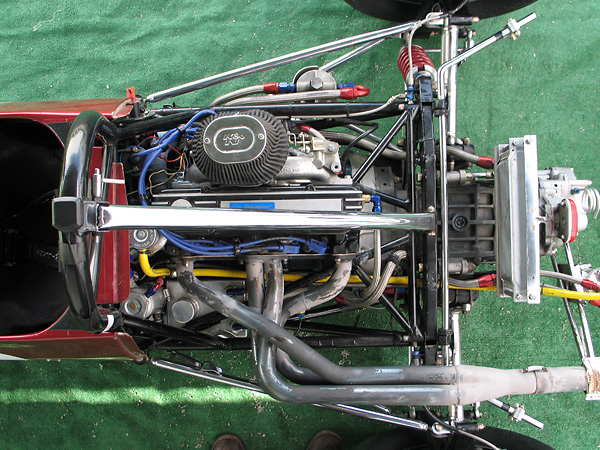
�
1.6L Ford four-cylinder, built by Quicksilver RacEngines.
�
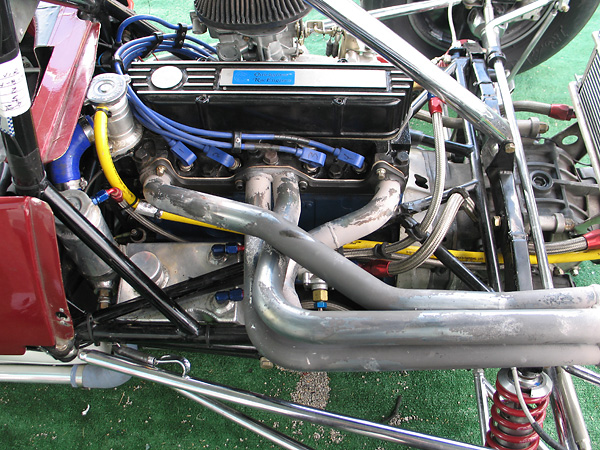
�
This exhaust header assembly was newly and temporarily installed when we saw it. Its design is neither
�
representative of an original Royale design nor of how this particular Royale RP3-A is usually raced.
�
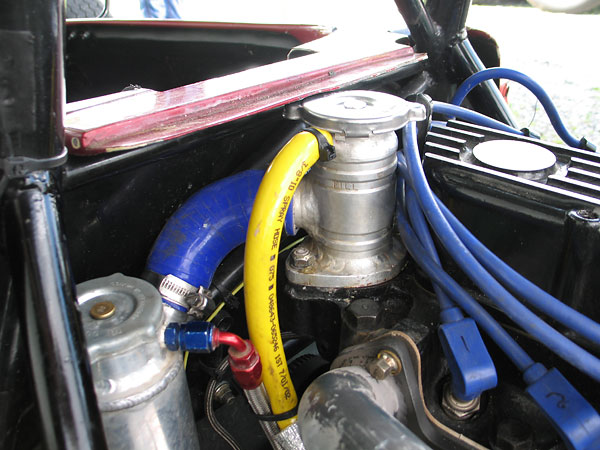
�
Scott made this special tall water filler neck to ensure completely filling of the cylinder head.
�
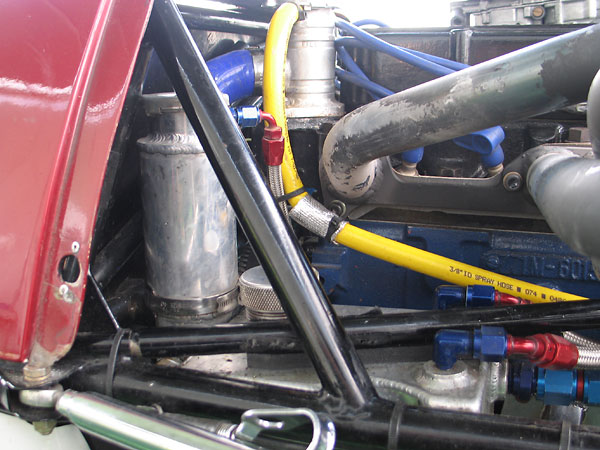
�
This aluminum swirl pot is original to the car. Both filler neck and swirl pot have 16# filler caps.
�
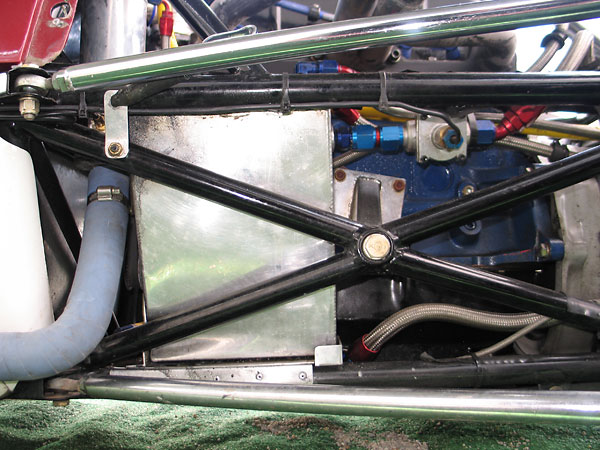
�
This oil reservoir tank is necessary because the engine is dry sumped. The engine is mounted so low
�
that it's really important that the flywheel be protected from contact with the ground by a skid plate.
�
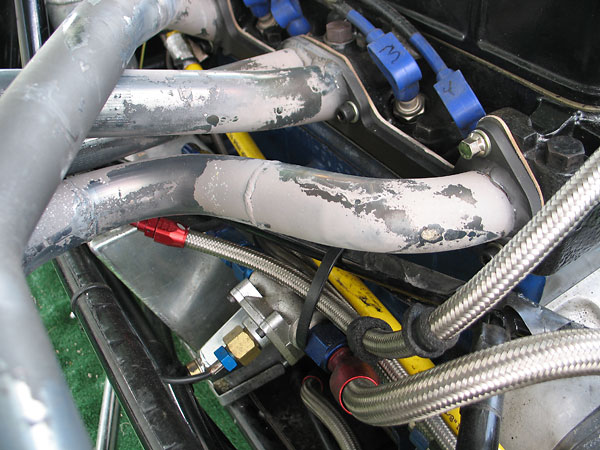
�
Oil temperature sensor.
�
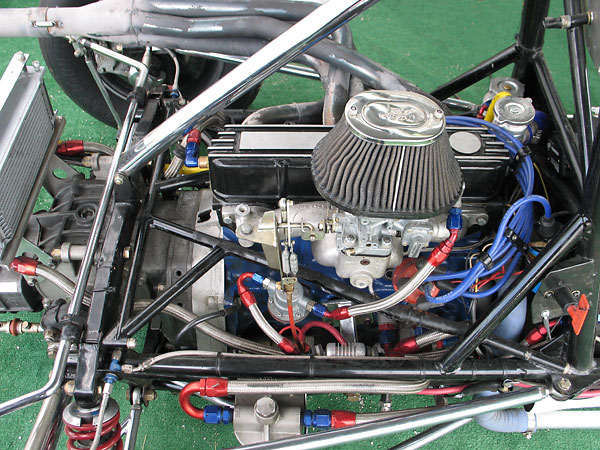
�
K&N air filter.
�
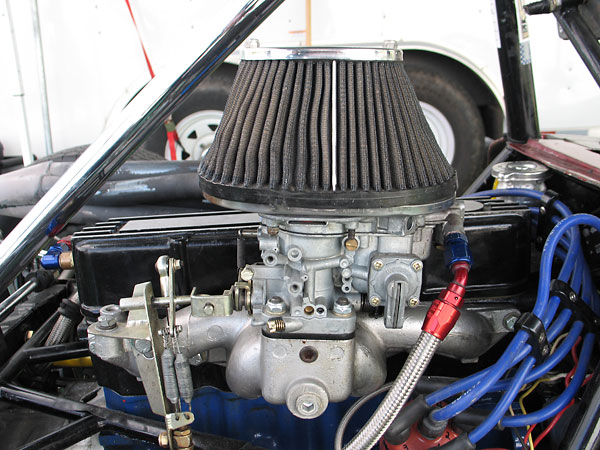
�
Weber 32/36 DGV carburetor.
�
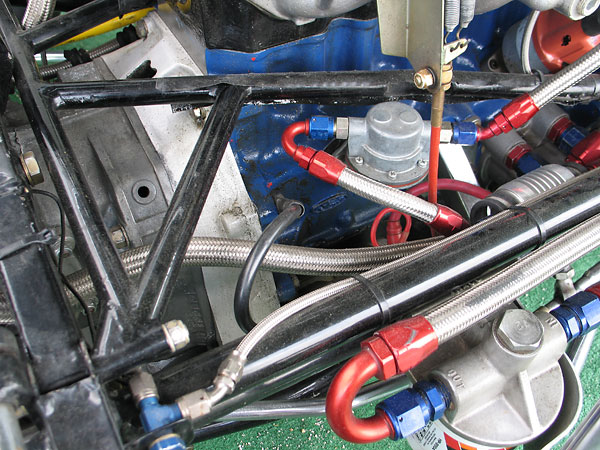
�
FF1600 fuel pump with repositionable 6AN fittings. K&N billet aluminum fuel filter.
�
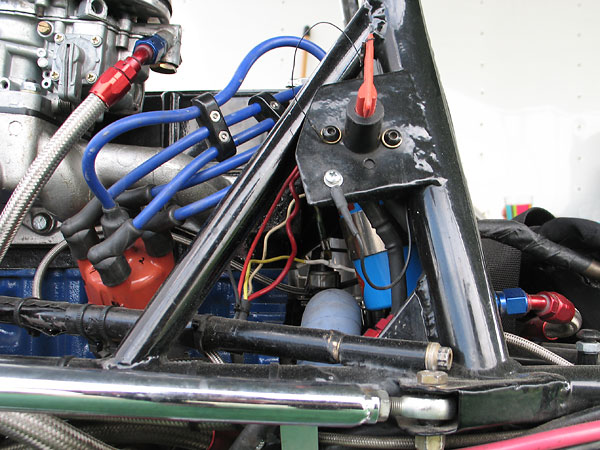
�
Bosch distributor (with Pertronix Ignitor inside) and Bosch "blue" ignition coil.
�
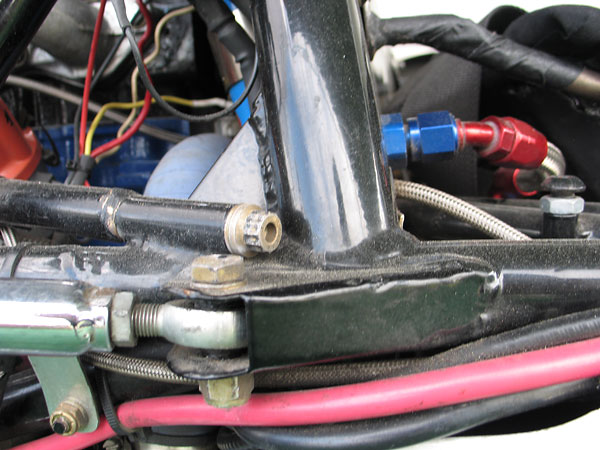
�
The RP3-A features an elaborate engine bay brace comprised of nine pieces of steel tubing.
�
It attachs at all four corners of the bay and adds significantly to chassis stiffness.
�
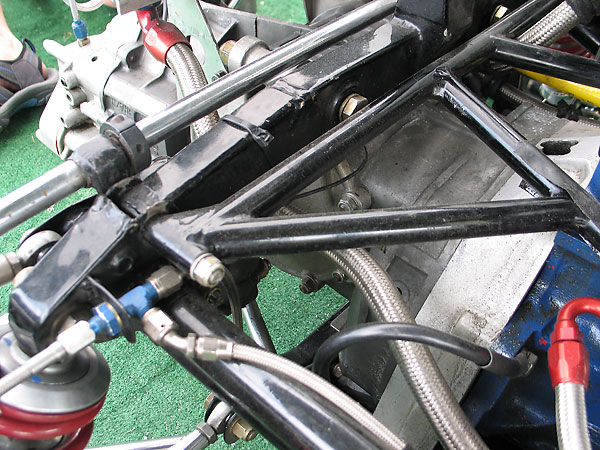
�
Close-up view of the engine bay brace (right-rear connection point).
�
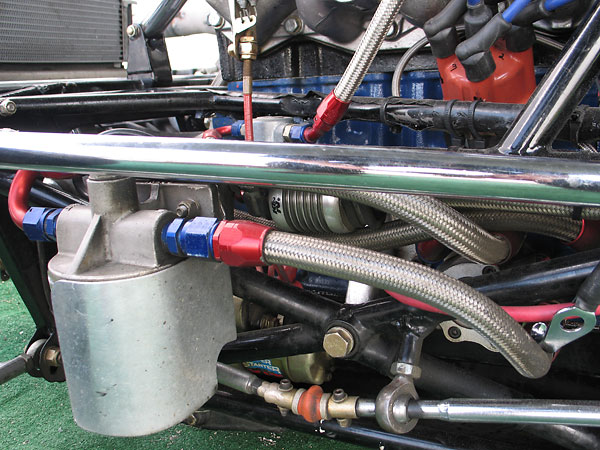
�
Tilton Super Starter XLT.
�
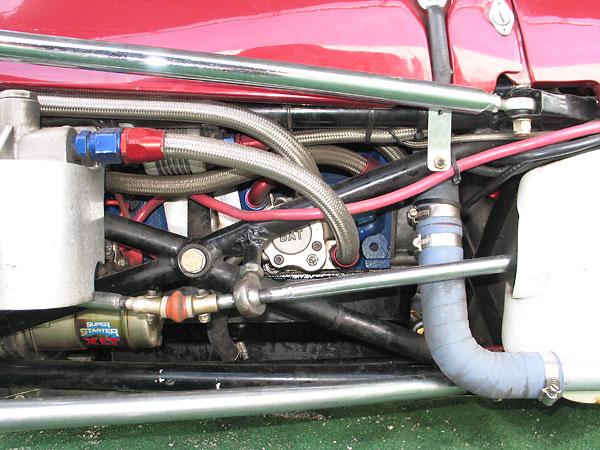
�
British American Transfer is an importer of Mocal, Setrab, and Laminova oil system products.
�
They also brand and distribute this style Formula Ford oil pump under their own name.
�
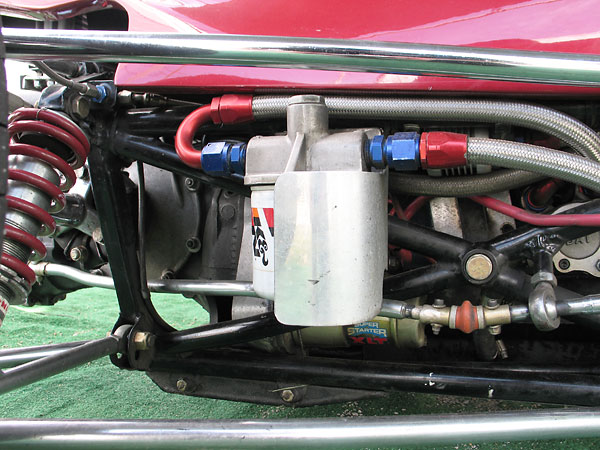
�
A simple aluminum shield protects the K&N HP2004 oil filter.
�
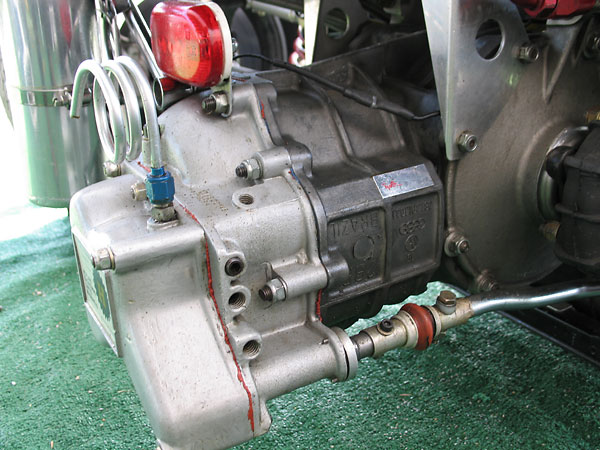
�
Hewland Mark 8 4-speed with reverse, rebuilt by Taylor Race Engineering.
�
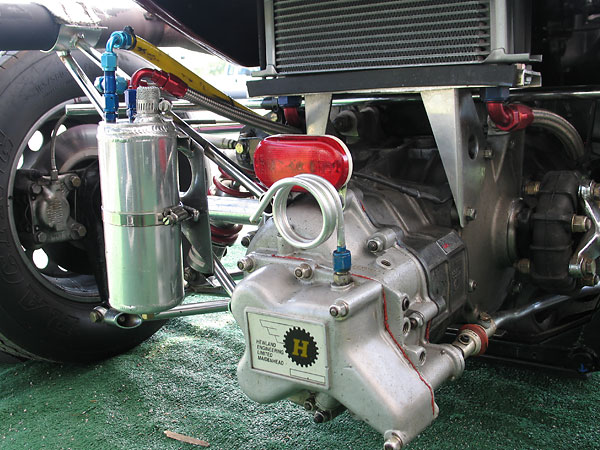
�
One of the most strictly enforced rules in this racing class is that cars must use rubber drive donuts
�
unless the car owner has convincing evidence the car was originally constructed without them.
�
�
Front Suspension, etc.
��
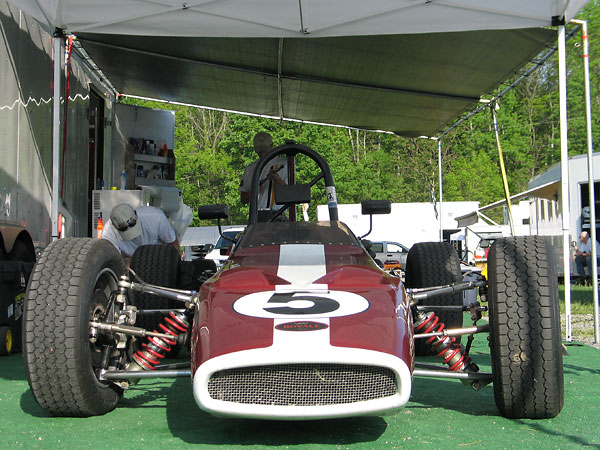
�
Balance! When tuning the suspension, Scott carefully sets cross-weights. The sum of diagonally paired
�
tire loads (left-front plus right-rear vs. right-front plus left-rear) is within two pounds, with driver installed.
�
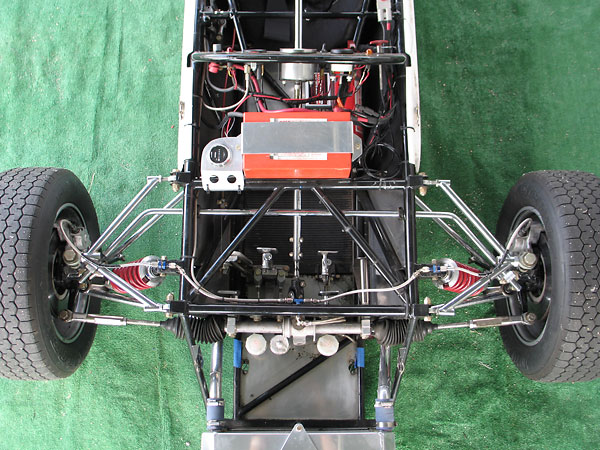
�
Dual Girling master cylinders (5/8" front, 0.700" rear) with bias bar.
�
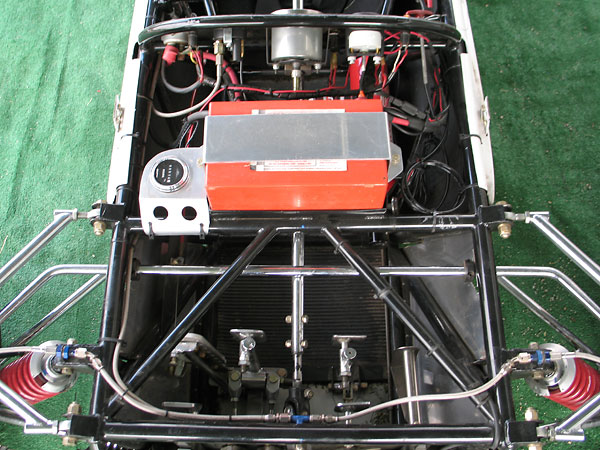
�
When Bill Scott imported Royale RP3/RP3A cars into U.S.A., he added two small diameter tubes to
�
reinforce their frames. This particular RP3-A wasn't imported by Scott, so they're not here.
�
Where would they be? From the multi-tube connection under the battery, they'd extend outward and
�
rearward about 30º to connect mid-span between existing connections on the frame longitudinals.
�
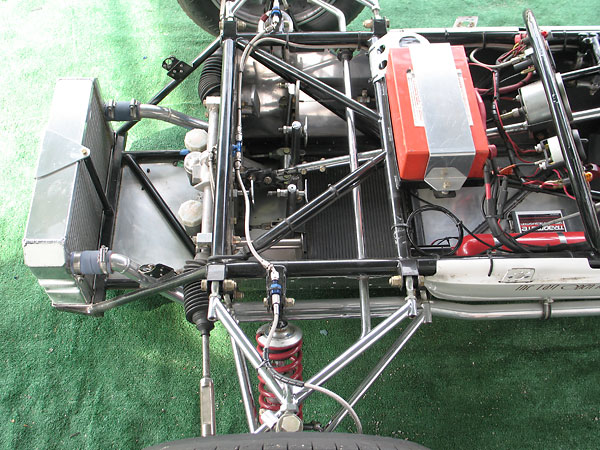
�
Royale differed from other early Formula Fords by not routing engine coolant through frame tubes.
�
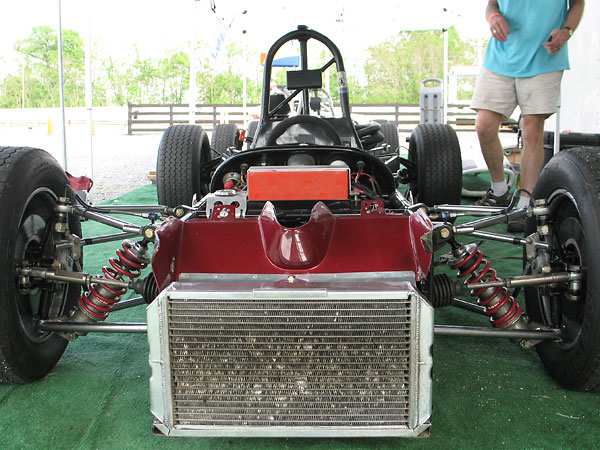
�
Custom 21-row crossflow aluminum radiator.
�
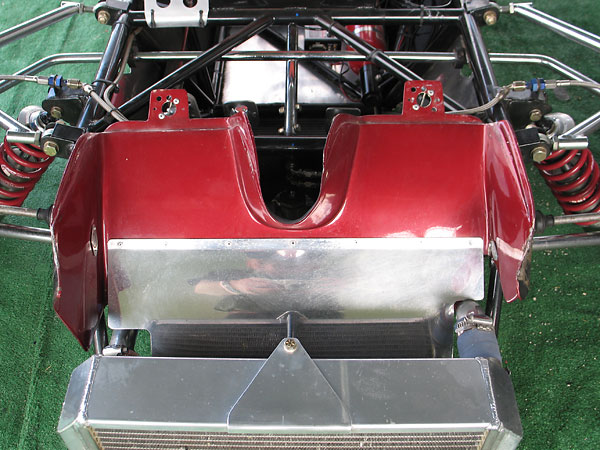
�
This radiator ductwork is secured in place by two Dzus quarter-turn fasteners.
�
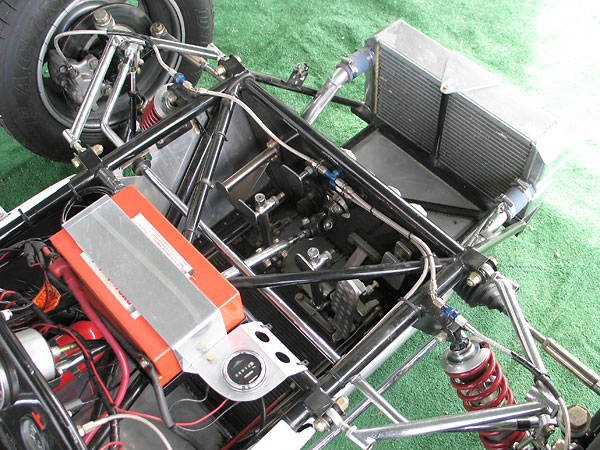
�
AutoMeter hour meter. The engine had been run about sixteen hours when we viewed the car. Competitive
�
vintage Formula Ford engines can be expected to run about forty hours before needing to be "refreshed".
�
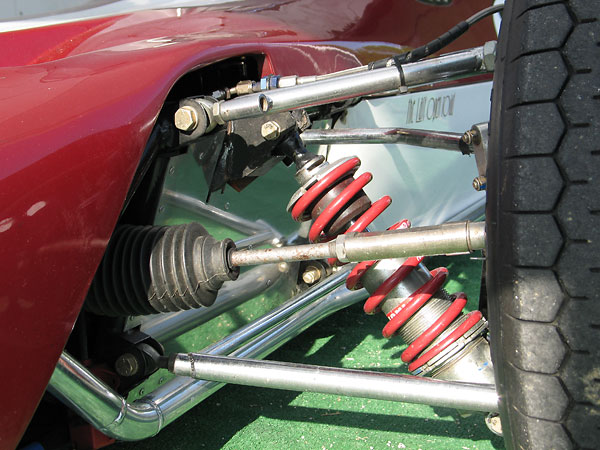
�
Koni steel bodied double adjustable coilover shock absorbers. Eibach springs (200 pounds per inch).
�
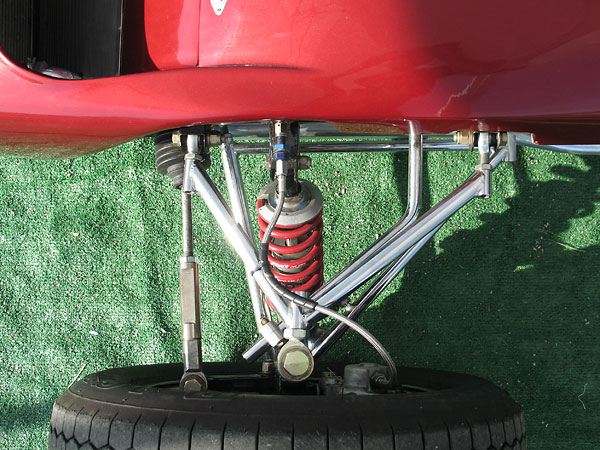
�
Steel-bodied shock absorbers are required by Monoposto vintage racing rules.
�
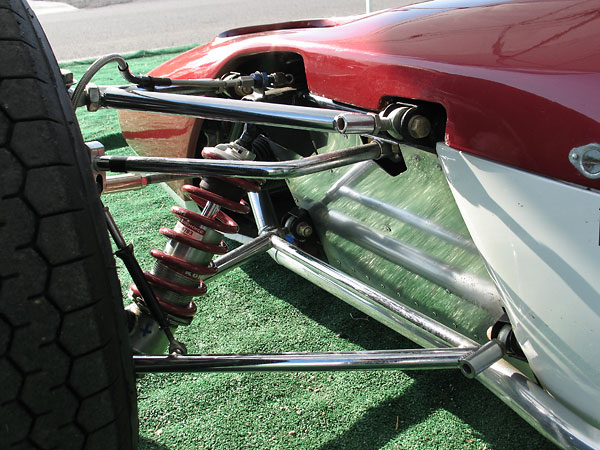
�
Royale used Heim joints instead of simple bushings for inner mounting points on both upper and lower
�
front control arms. This is one important way in which the early Royale Formula Fords are more
�
easily and more precisely tuneable than competitive cars like the Merlyn 11A and the Lotus 61.
�
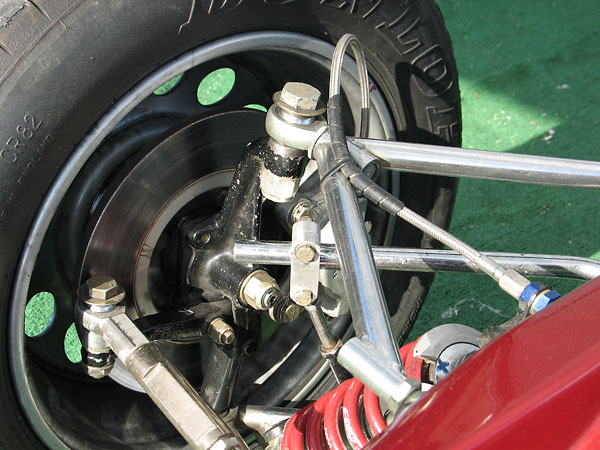
�
Triumph (Alford & Alder) forged front upright. Note that a carefully selected aluminum spacer is
�
installed between steering arm and the Heim joint type tie rod end to eliminate bump steer.
�
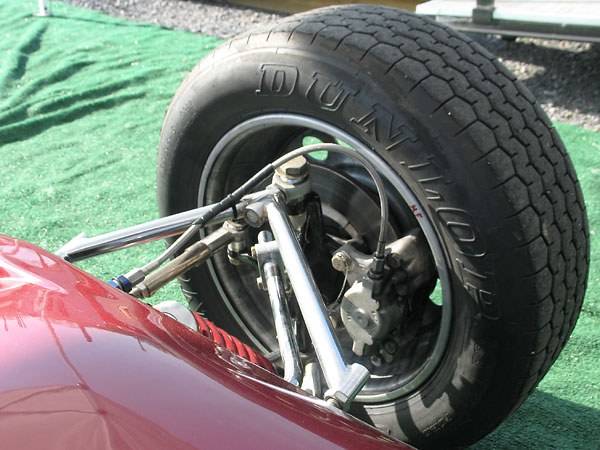
�
This Royale came with one size larger front brake calipers (Girling 14SP) than some contempories.
�
�
Rear Suspension
��
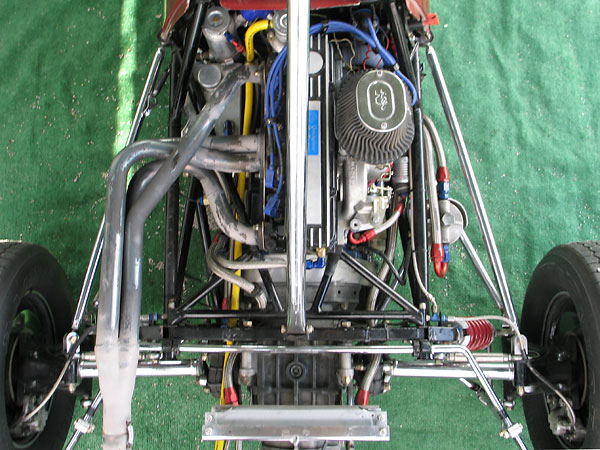
�
Elaborate symmetrical removeable bracing across the top of the engine bay to enhance chassis stiffness.
�
(Most competitive cars had a simpler dog-legged brace connecting one pair of opposite corners.)
�
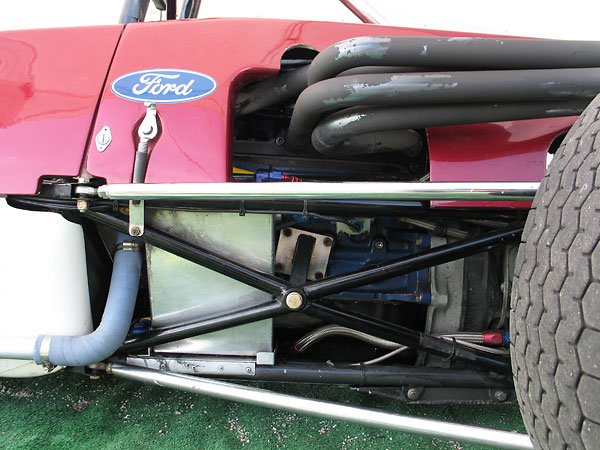
�
Oppositely threaded (left-hand/right-hand) Heim joints facitate easy adjustment of trailing link length.
�
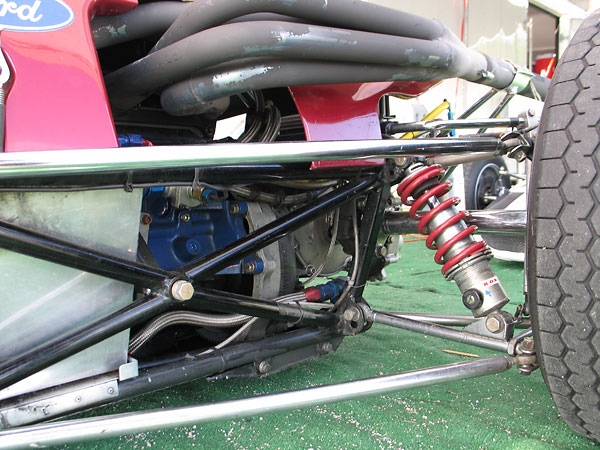
�
Koni steel bodied double adjustable coilover shock absorbers. Eibach springs (300#/inch).
�
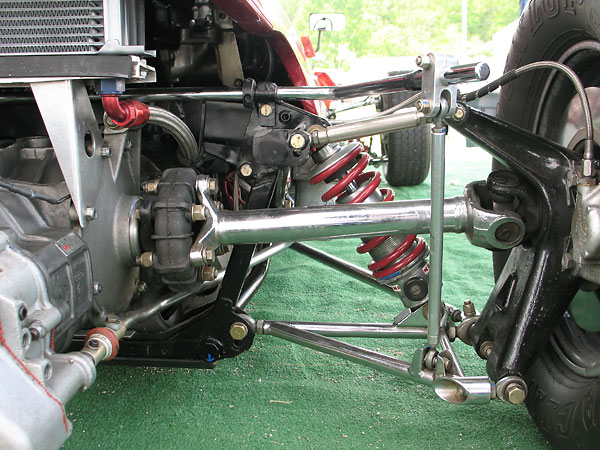
�
After using Lotus uprights on the original ("RP1") prototype, Royale
�
had magnesium rear uprights cast to their own design.
�
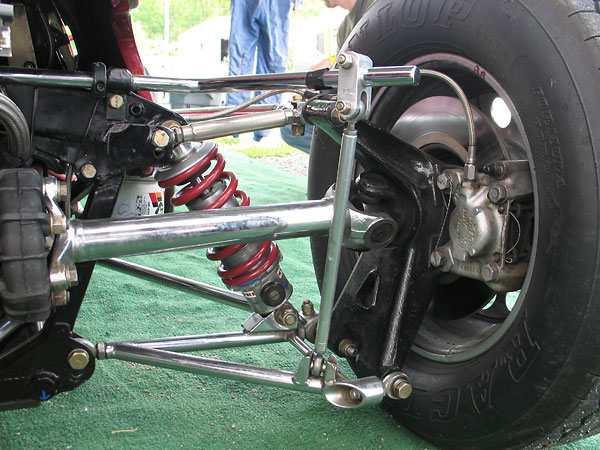
�
The early Royale Formula Fords came standard with Heim joints installed at both ends of the rear-lower
�
control arms. As on the front-upper control arms, this is a tangible technical advantage over competitive
�
cars such as the Merlyn 11A or the Lotus 61 because it facilitates both easier and more precise
�
suspension tuning. Rear toe-in is adjustable with minimal disturbance of caster and wheelbase settings.
�
Interior
��
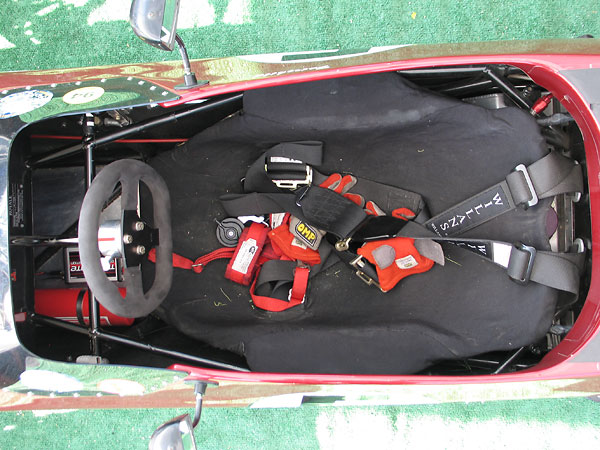
�
Custom-fitted drivers seat. Willans six-point cam-lock safety harness.
�
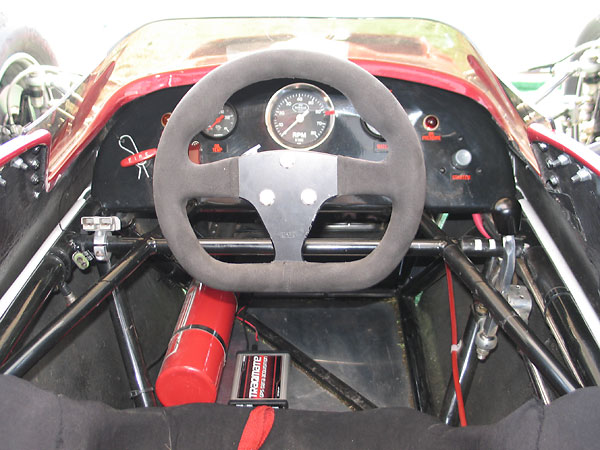
�
Royale-labeled (0-8000rpm) tachometer was made in England by Icknield Instruments.
�
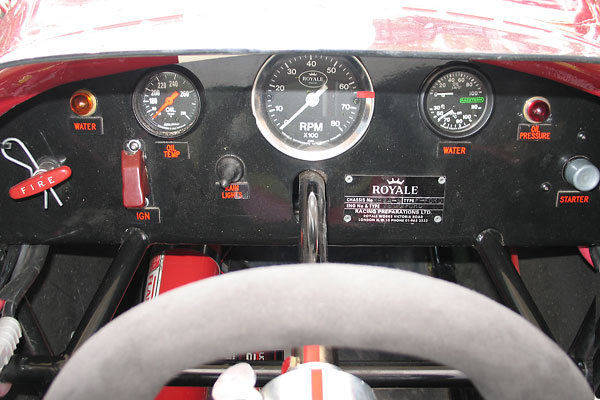
�
AutoMeter oil temp (140-280F) gauge. Racetech dual oil pressure (0-100psi) & coolant temp (30-110C) gauge.
�
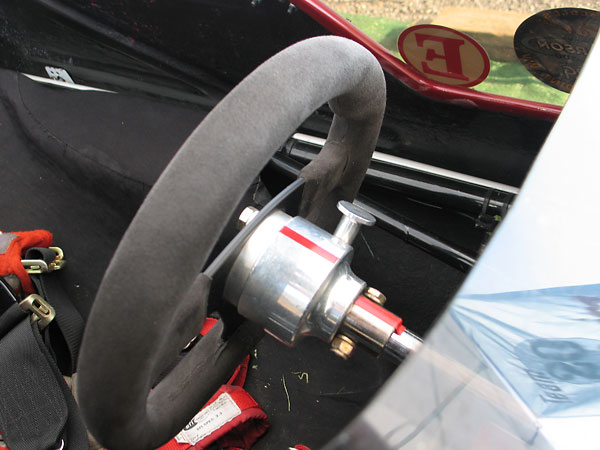
�
Quick release steering wheel hub, on an Alpha D-shaped steering wheel.
�
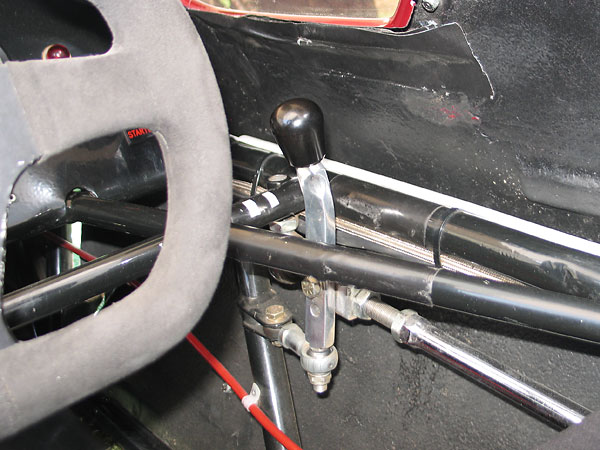
�
Shifter lever.
�
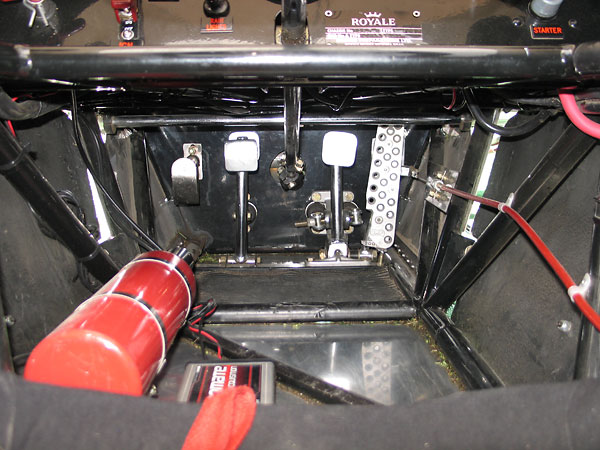
�
Halon fire extinguisher.
�
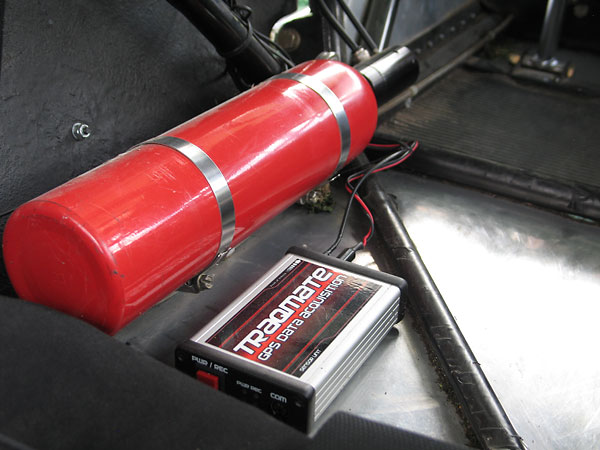
�
Traqmate GPS data acquisition system.
�
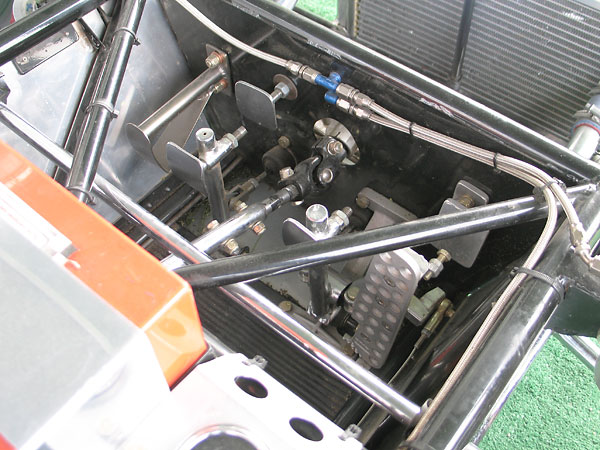
�
The pedals have been updated. Note the robust cast aluminum brake pedal bracket and the large,
�
adjustable pedal stops. The OMP cast aluminum throttle pedal is a modern addition too.
�
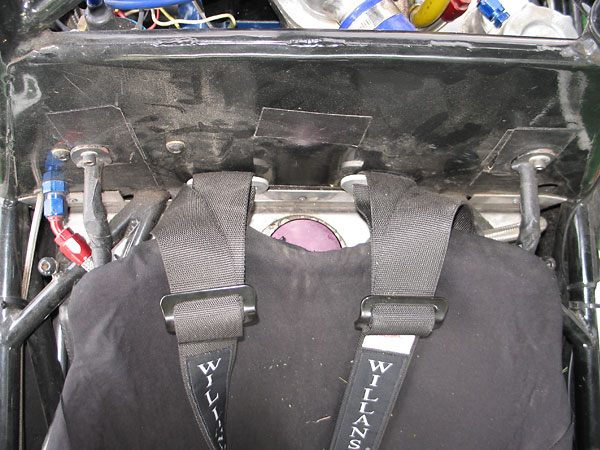
�
Custom Fuel Safe aluminum fuel cell, mounted under drivers seat.
�
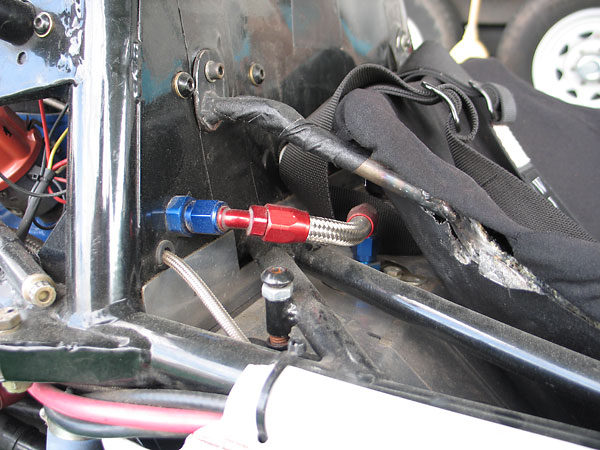
�
Driver seat brackets to the firewall, and hold-downs that secure the under-seat fuel cell.
�
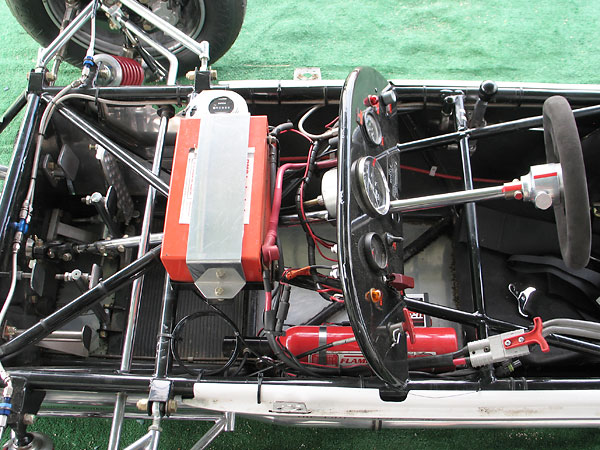
�
DMS/Varley "Red Top" battery. Note the auxiliary battery connector, opposite the gear selector,
�
which is used for connecting a battery charger and for quick and easy jump starts.
�
�
Exterior
��
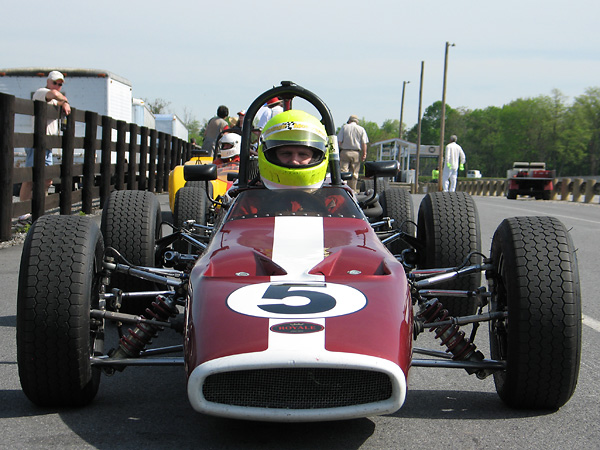
�
Royale relied on Arch Motors for tubular frames and on Specialised Mouldings for fiberglass bodywork.
�
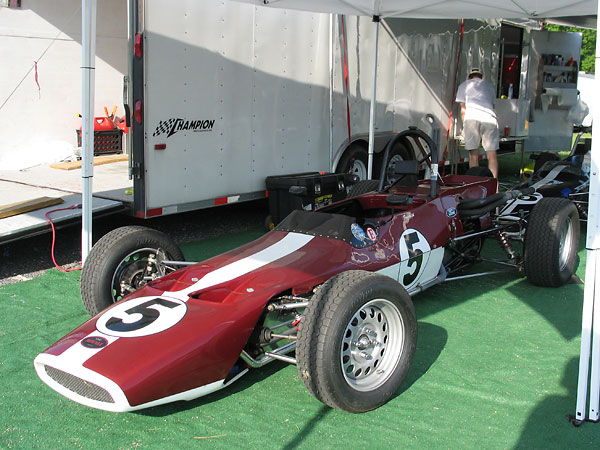
�
The most apparent differences between the RP2 and RP3 models were updates to bodywork. There were
�
also minor changes to the suspension, but RP2 owners could update their cars with RP3 parts.
�
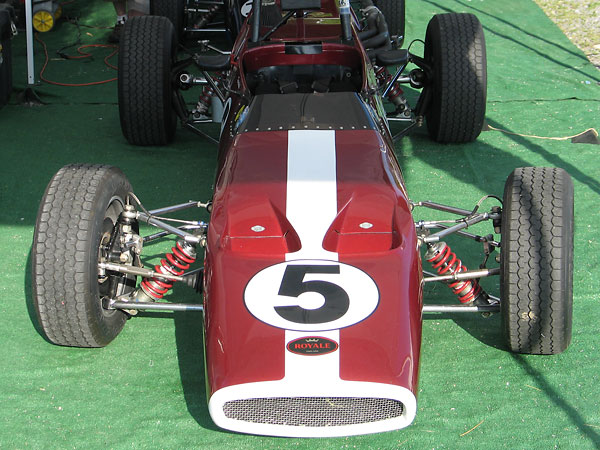
�
On the Royale RP2, cooling air exited through the openings for the front suspension.
�
On the RP3 and RP3-A this airflow was ducted upward through "nostrils".
�
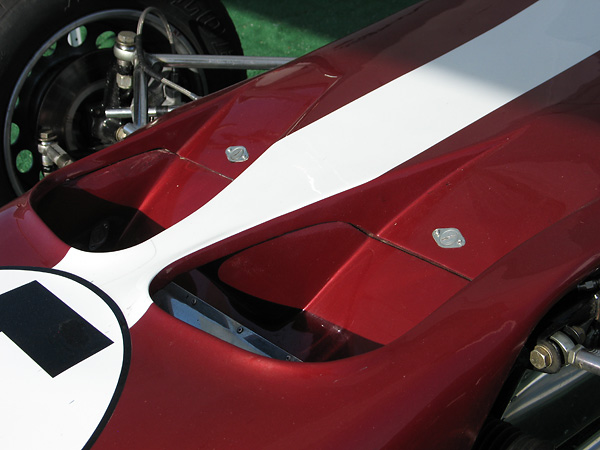
�
Close-up view of the nostrils that are distinctive of the RP3 & RP3-A models.
�
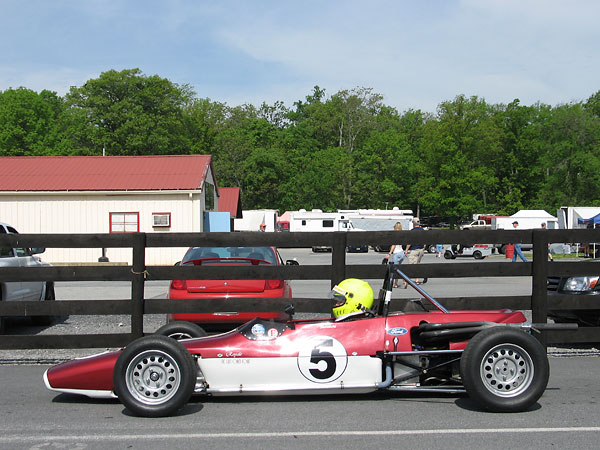
�
Another bodywork difference was a longer tail section on the RP3 and RP3-A, compared to the RP2.
�
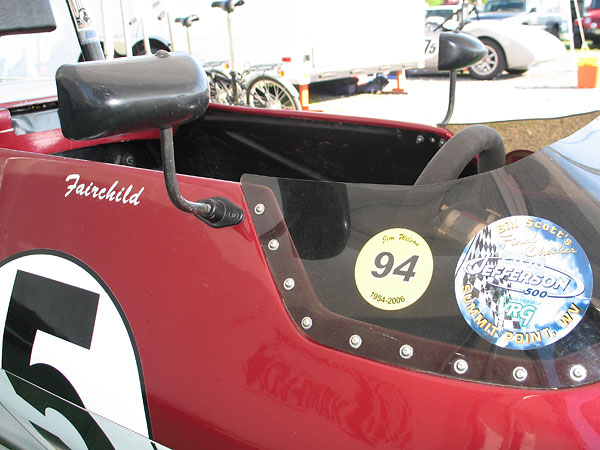
�
The tagline for this year's Jefferson 500 race weekend at Summit Point Motorsports Park was "Bill Scott's
�
Final Checker." As we honored the huge role Bill Scott (1938-2009) played in advancing motor racing in
�
North America, it was fitting that this outstanding Royale racecar on hand. Bill Scott's success and
�
the success of the Royale company were closely linked, particularly from 1968 through the early 1970's.
�
(SPA "F1" mirrors with black nylon housings. Scott custom made the extra long mirror mounting arms.)
�
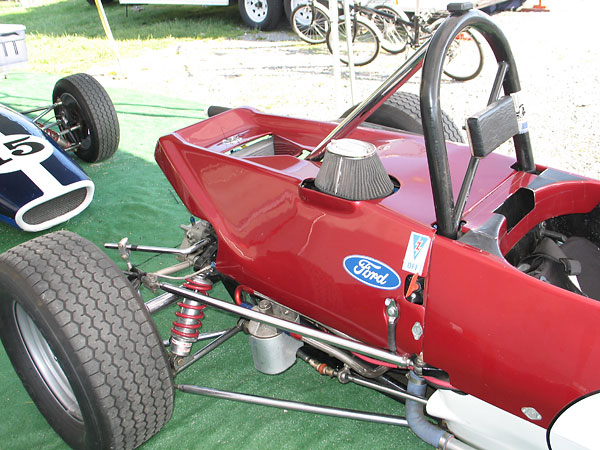
�
To comply with more rigorous modern safety standards, we often see that rollhoops have been updated.
�
The original Royale rollhoop design didn't include a headrest, and the hoop was somewhat narrower.
�
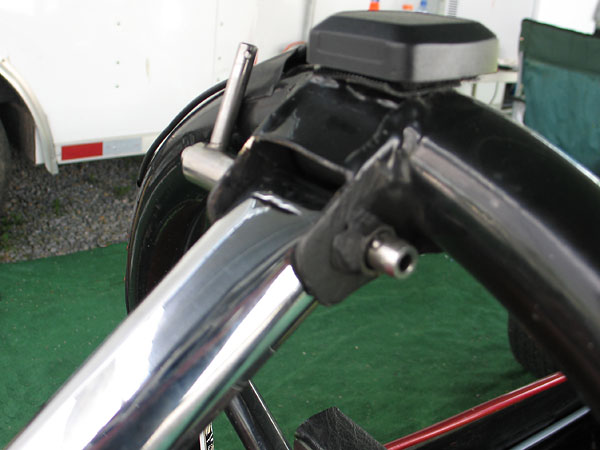
�
In the original design, the rearward rollhoop brace was smaller diameter and ended in Heim joints.
�
(This photo shows the antenna for a GPS based data acquisition system.)
�
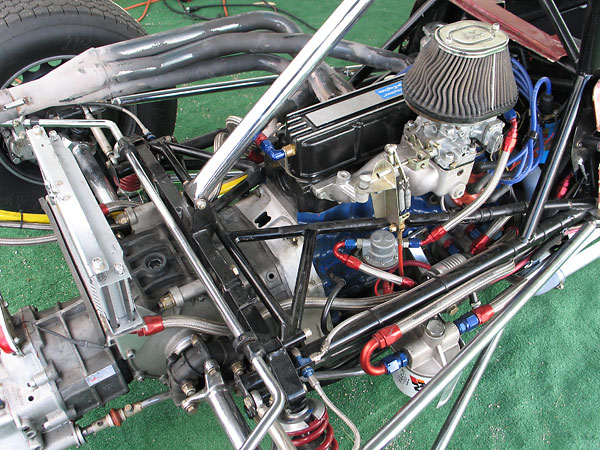
�
Close-up of the brace's lower attachment. Note also that the Mocal engine oil cooler isn't bolted down
�
tightly. Experience has shown that for longevity it's important that these oil coolers be "shock-mounted".
�
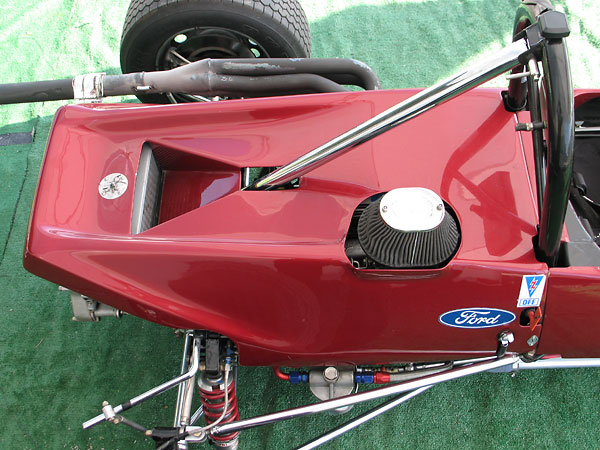
�
This rear body section has a bigger hole for the air cleaner than Royale originally provided.
�
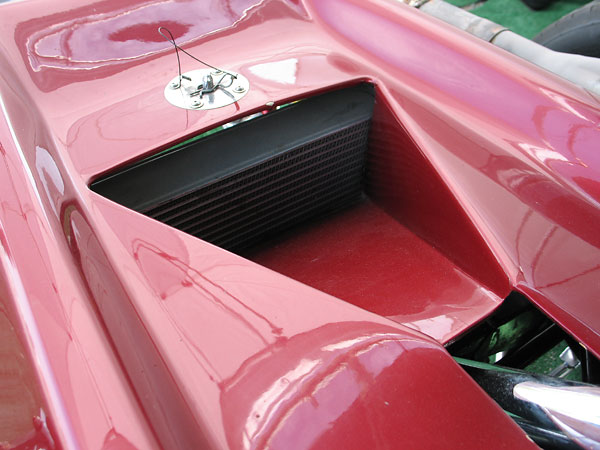
�
This nicely detailed oil cooler duct is a modification of this particular Royale RP3-A.
�
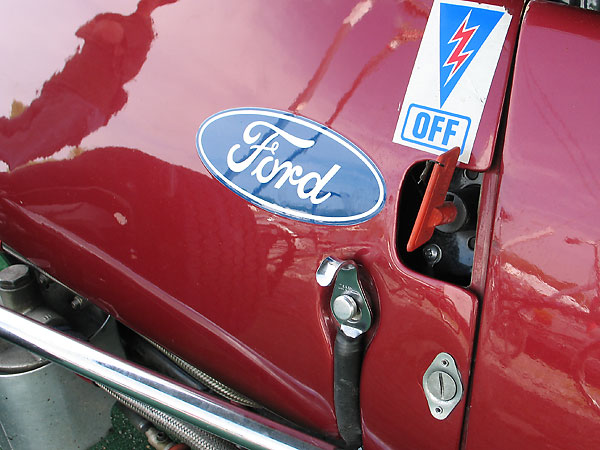
�
Emergency kill switch (battery disconnect) and also the hold-down clamp for the rear bodywork.
�
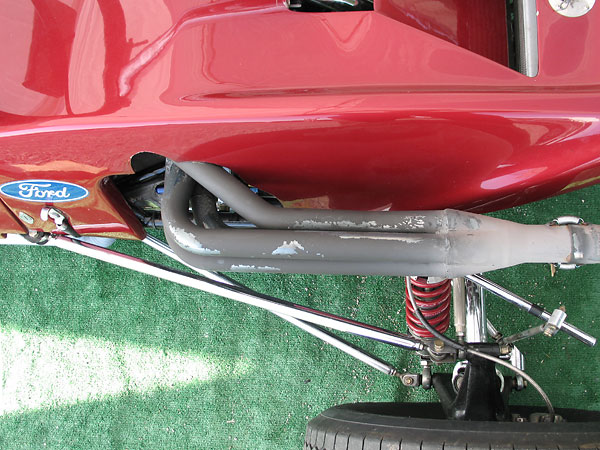
�
This is a two day old BAT "Crossle-style" exhaust header. Since this photo was taken, the header
�
has been Jet-Hot (ceramic) coated and it's now much more attractive and also cooler running. The
�
photo shows how bodywork has been trimmed back slightly to suit the header's installation.
�
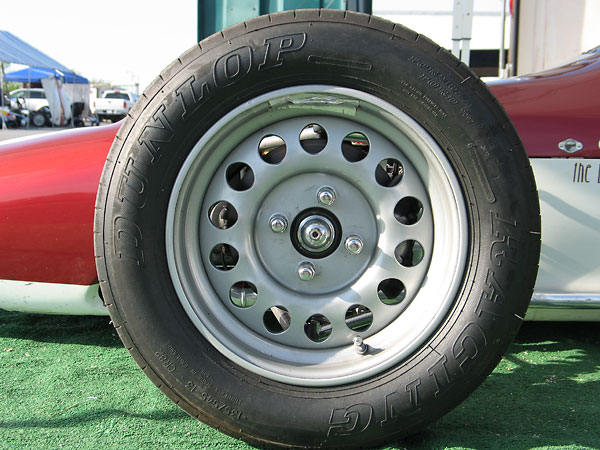
�
Weller steel disc wheels are popular for Formula Fords because they're relatively lightweight.
�
(Cast aluminum and magnesium wheels are strictly forbidden by vintage Formula Ford class rules.)
�
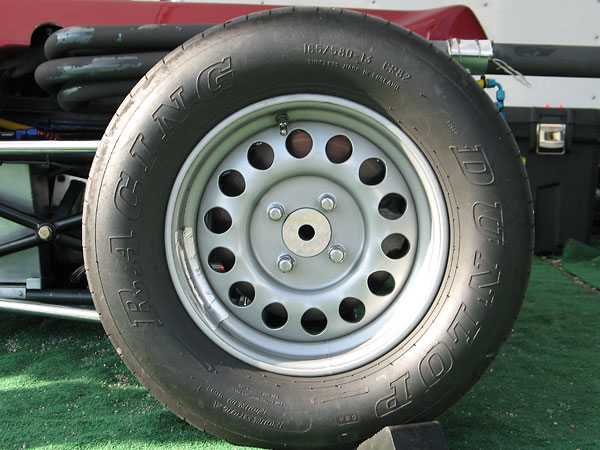
�
Dunlop Racing "Formula Ford" tires: 135/545-13 CR82 front / 165/580-13 CR82 rear.
�
Addendum
��
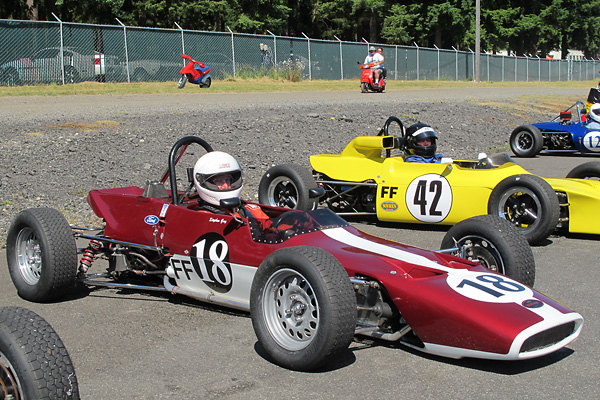
�
Since this article as originally published, Steve Guy has purchased the Royale RP3A.
�
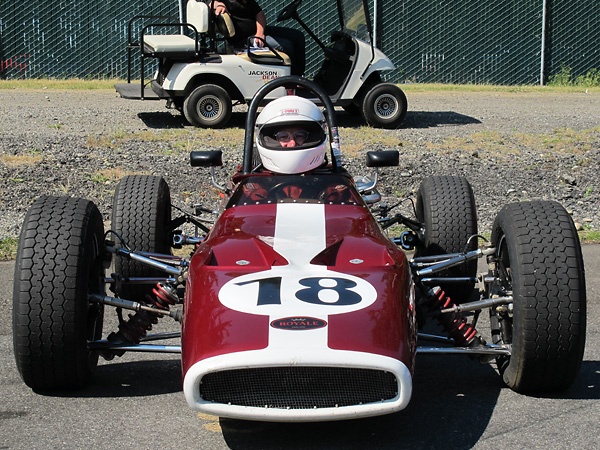
�
Steve will be campaigning the car in the from his base in Idaho. We enjoyed meeting Steve
�
and seeing him race at SOVREN's "Pacific Northest Historics" in July 2011.
�
| Notes: | |||||||
| (1) | �
Later in his distinguished career, Bob Marston briefly rejoined Royale as Technical Director. �
In 1981 he designed their highly successful Sports 2000 racecars, and also their 1982 and 1983 �
Formula Ford 1600 and 2000 cars before leaving racing for a second career in the aerospace industry. �
� | ||||||
�
Unless otherwise noted, all photos shown here are from April 2010 when we viewed the car at VRG's Jefferson 500�
at Summit Point Motorsports Park, West Virginia. Photos by Curtis Jacobson for BritishRaceCar.com, �
copyright 2010. All rights reserved.
�
| If you liked this article, you'll probably also enjoy these: | �|||||
 | �
Dick Leehr '68 Lotus 51c | �
 | �
Dave Fairchild 1969 Merlyn 11A | �
 | �
Gord Leach '74 Hawke DL11 | �
| You're invited to discuss anything you've seen here on The British Racecar Motorsports Forum! | �|||||
�
Notice: all the articles and almost all the photos on BritishRacecar.com are by Curtis Jacobson.
�
(Photos that aren't by Curtis are explicitly credited.) Reproduction without prior written permission is prohibited.
�
Contact us to purchase images or reproduction permission. Higher resolution images are optionally available.
�

 �
�